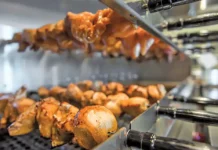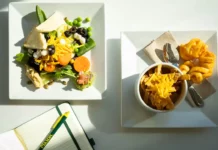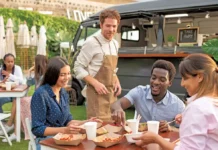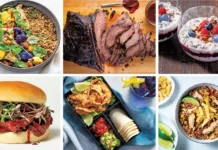
This original report was published by the Application Resource Center (ARC), which is an editorial and research arm of the app quality and testing company, Applause, and reposted here with permission.
People are hungry for restaurant apps.
According to RetailMeNot, one in four U.S. consumers have at least one restaurant app on their phone. Restaurant apps come in all kinds of sizes with features like order ahead, loyalty perks, favorite orders, digital coupons, mobile payments and more. 
The unfortunate reality is that most restaurant chains have not yet risen to the expectations of their mobile customers. The concept of “food tech” is often an oxymoron. For example, 45 out of the top 100 restaurant brands lack a native app altogether. Sure, most have a mobile website or responsive site that displays their menu and locations — but customers expect richer, location-based and transactional engagement.
Even restaurants with native apps have room to improve, according to their own U.S. customers. ARC from Applause analyzed nearly one million app store reviews in the App Store and Google Play of the 100 most successful restaurant chains based on U.S. sales, as profiled in Nation’s Restaurant News Top 100 Report. A stark contrast became immediately apparent between the mobile leaders, such as Domino’s, Starbucks, Five Guys, Pizza Hut and Taco Bell, and the laggards, too numerous to mention but profiled below.
Inspiration From The Trailblazers
When done right, an effective mobile app profoundly impacts the bottom line. Native apps work best with active behaviors. What is more active than ordering (and eating) food?
For evidence, look no further than Starbucks, Domino’s and Taco Bell.
Starbucks’ mobile app accounted for 21% of its Q1 U.S. transactions. It’s top feature, Mobile Order & Pay, represents 10% of total transactions at high-volume Starbucks stores, directly contributing to increased sales (Mobile Strategies 360). Domino’s supports payment across 15 platforms, including Apple Watch, Amazon Echo and Samsung TV. More than half of U.S. sales are driven through digital (Business Insider). Taco Bell experiences 20% higher average orders on mobile than in-store purchases (Mobile Commerce Daily).
These success stories are proof points that, when brands match and surpass expectations, customers (and restaurants) win. But it’s not as easy as engaging with Tillster or Olo to launch new digital engagement platforms, mirroring an established leader or hoping that what your developer partner delivers can withstand real world challenges without testing outside of the test lab and beyond internal employees.
The 2016 State Of Restaurant Apps
Leveraging Nation’s Restaurant News Top 100 Report, ARC analyzed the mobile user sentiment of every restaurant’s flagship native Android and iOS apps. We did this via Applause Mobile Sentiment Analysis, a subscription-based SaaS tool that continuously crawls app store reviews and measures on a 100-point scale how users perceive the quality of mobile apps.
In total, 55 of the 100 restaurant brands qualified for analysis. These chains have native Android and/or iOS apps with a statistically significant cumulative volume of app store reviews. The apps, relied on by consumers around the country and in some cases the world, garnered nearly one million app store reviews in the U.S. alone. ARC stack ranked the 55 restaurant chains based on a weighted average of their Android and iOS mobile user sentiment scores (see Figure 1).
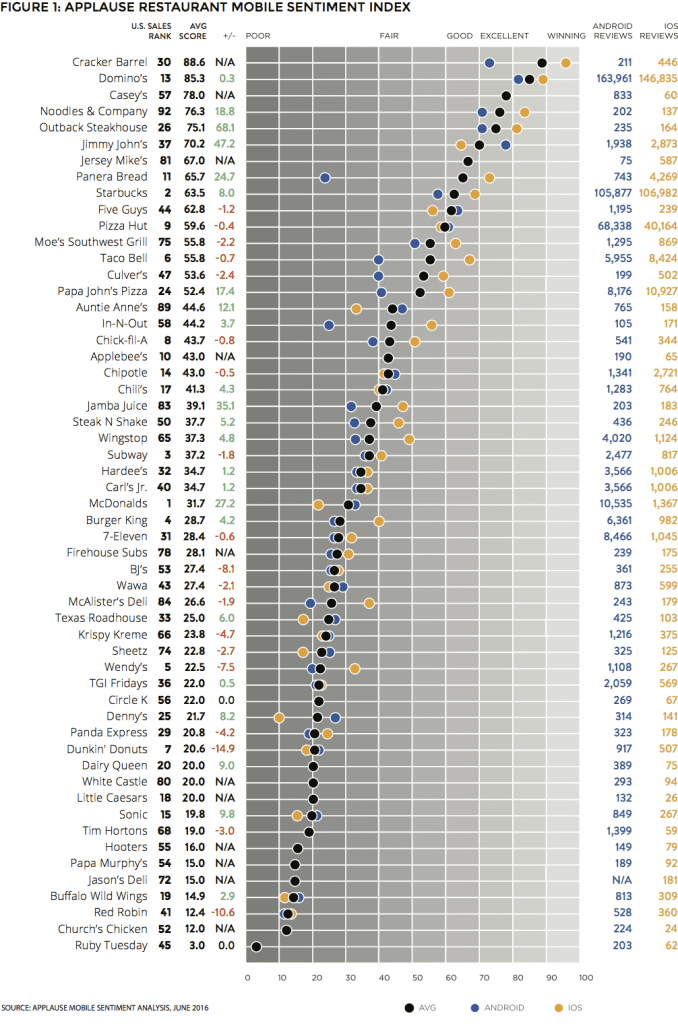
We further categorized these brands by restaurant type, including: fast food (the most popular with 27 brands), fast casual (15 brands) and casual dining (13 brands). There was a fourth type: fine dining, but Ruth’s Chris doesn’t have an app and The Capital Grille lacked reviews. Somewhat surprisingly, fast casual beat fast food as the highest-rated restaurant type (see Figure 2).

Forty-five restaurant chains failed to qualify due to a lack of native apps (34 brands) or had apps but with fewer than 150 cumulative app store reviews (11 brands). In the 2017 edition of this report, ARC remains bullish that this list will shrink as restaurants unleash their upcoming mobile investments and engage more effectively with their customers via digital and mobile channels (see Figure 3).
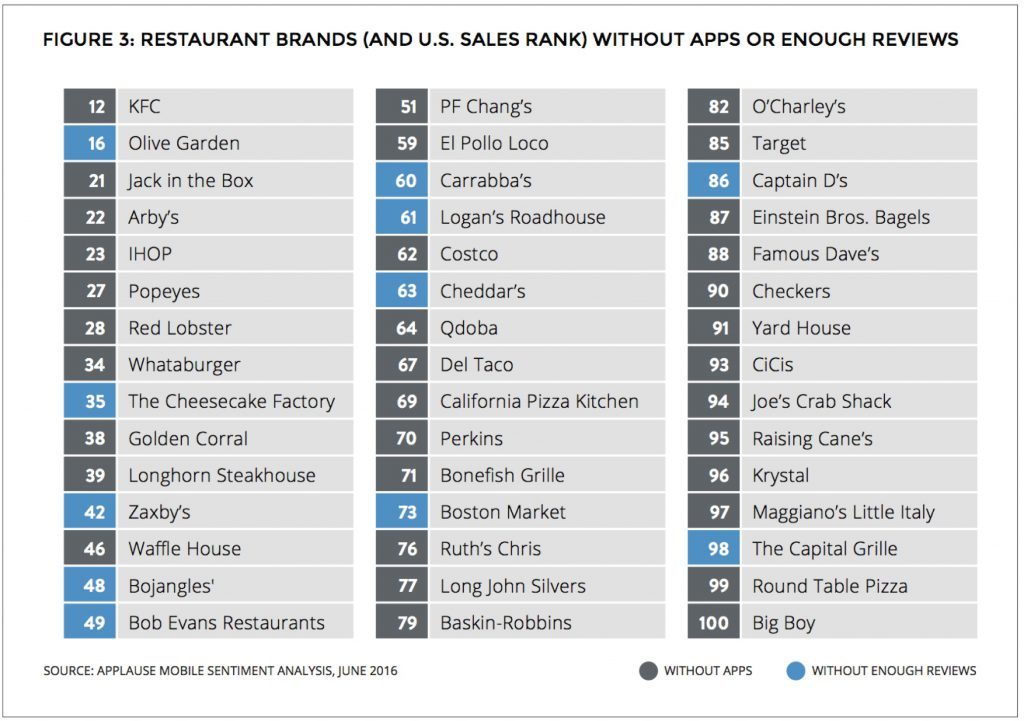
8 Popular Apps Earn High Quality Marks
Across the more than 30 million apps Applause Mobile Sentiment Analysis crawls globally in real time, the average mobile sentiment score is a 67.3. The most successful restaurants are far below this global benchmark, coming in with a 37.8 weighted average.
It’s time that restaurants reset the expectations their customers have in them by launching and sustaining high-quality digital engagement channels. Eight incredibly popular brands earned weighted averages of 55 or greater based on more than 1,000 reviews:
- Domino’s (85.3, ~311K reviews) [Android | iOS]
- Jimmy John’s (70.2, ~5K reviews) [Android | iOS]
- Panera Bread (65.7, ~5K reviews) [Android | iOS]
- Starbucks (63.5, ~213K reviews) [Android | iOS]
- Five Guys (62.8, ~1K reviews) [Android | iOS]
- Pizza Hut (59.6, ~109K reviews) [Android | iOS]
- Moe’s Southwest Grill (55.8, ~2K reviews) [Android | iOS]
- Taco Bell (55.8, ~14K reviews) [Android | iOS]
Is anyone actually surprised that Domino’s, Starbucks, Pizza Hut and Taco Bell have four of the five most heavily reviewed apps (Papa John’s Pizza is the fifth) and among the highest-rated restaurant apps? These four have been and remain trailblazers in the fast food/QSR industry (see Figure 4).
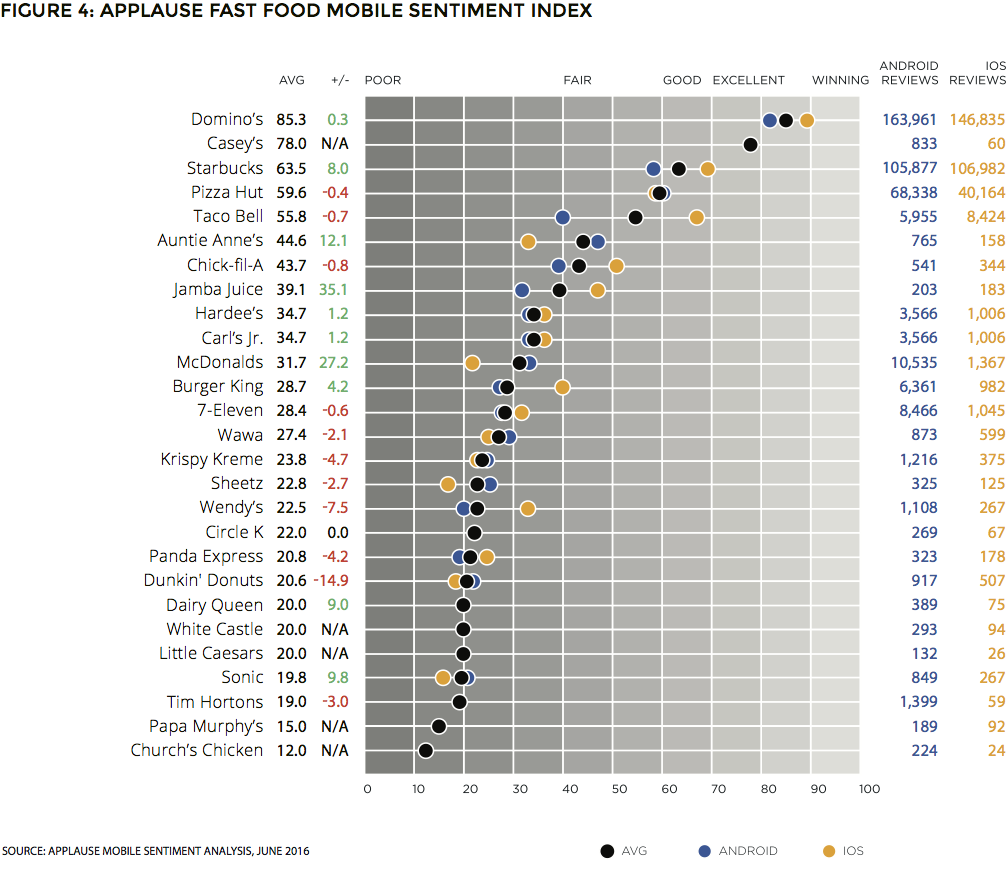
Now the fast casual industry is bringing similar levels of investment and focus on the needs of its customers. Apps from Jimmy John’s, Panera Bread, Five Guys and Moe’s Southwest Grill are among the highest-rated (see Figure 5).
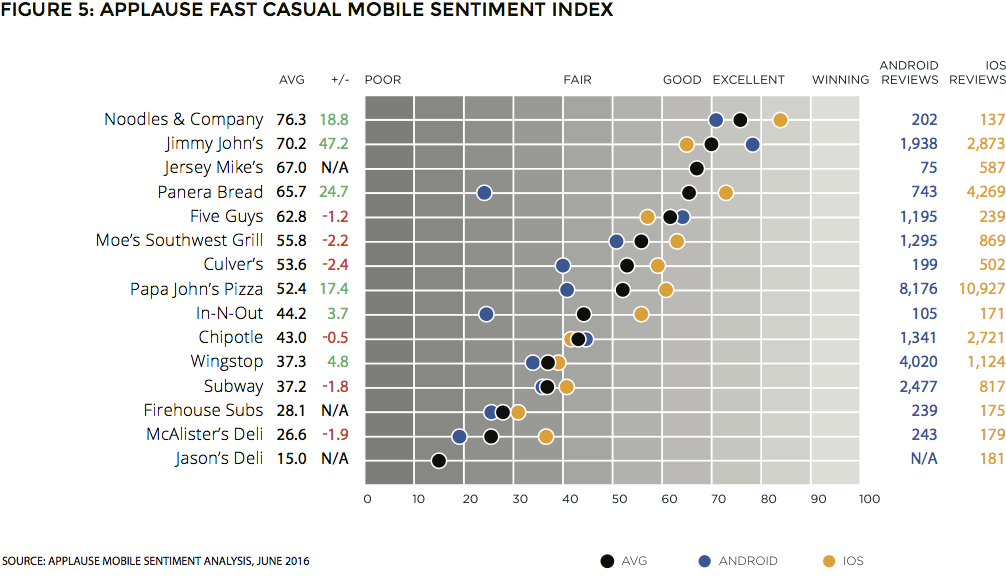
Because the use case for native apps in the casual dining industry is lesser in comparison to the fast food and fast casual sectors, no casual dining apps were among the most reviewed. However, shout-outs are deserved for Cracker Barrel and Outback Steakhouse (see Figure 6). Cracker Barrel, for thinking differently and engaging with customers via in-restaurant games, and Outback Steakhouse, for allowing customers to check wait times and pay when they’re ready through the app instead of a server.
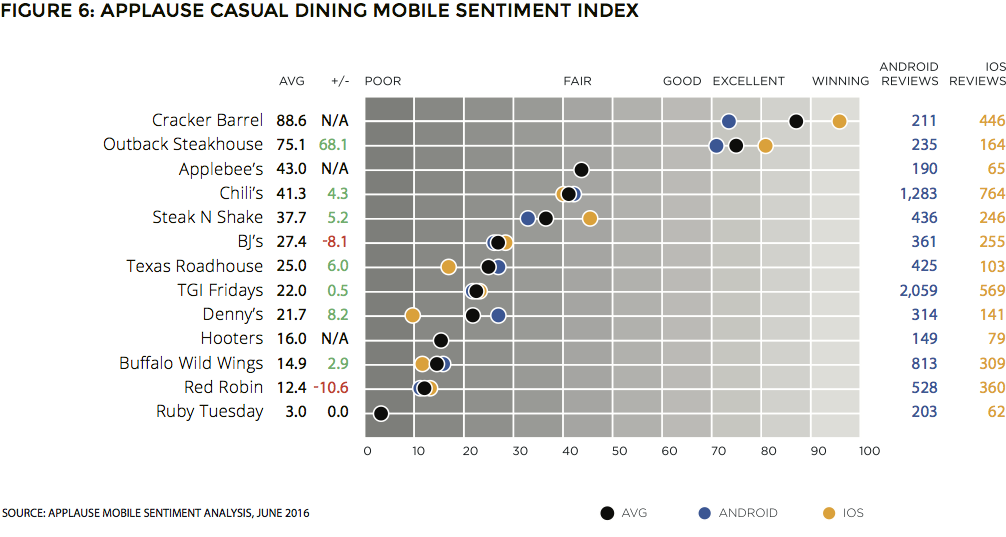
11 Apps That Have Room To Improve
We can’t all be winners. Interestingly, four of the top ten restaurant chains based on U.S. sales landed in dubious company, including No. 1 McDonalds, No. 4 Burger King, No. 5 Wendy’s and No. 7 Dunkin’ Donuts (more on Dunkin’ Donuts below). In all, eleven restaurant chains with apps that accumulated more than 1,000 reviews were hit with mobile sentiment scores less than 33:
- McDonalds (31.7, ~12K reviews) [Android | iOS]
- Burger King (28.7, ~7K reviews) [Android | iOS]
- 7-Eleven (28.4, ~10K reviews) [Android | iOS]
- Wawa (27.4, ~1K reviews) [Android | iOS]
- Krispy Kreme (23.8, ~2K reviews) [Android | iOS]
- Wendy’s (22.5, ~1K reviews) [Android | iOS]
- TGI Fridays (22.0, ~3K reviews) [Android | iOS]
- Dunkin’ Donuts (20.6, ~1K reviews) [Android | iOS]
- Sonic (19.8, ~1K reviews) [Android | iOS]
- Tim Hortons (19.0, ~1K reviews) [Android | iOS]
- Buffalo Wild Wings (14.9, ~1K reviews) [Android | iOS]
Poorly rated apps are often not optimized for frequent micro engagements, requiring multi-input navigation (i.e., not tailored for the most common customer journeys and frequent touch points, such as finding nearest location, displaying the menu, ordering ahead, etc.). Or they lack the features customers expect (i.e., order ahead, loyalty programs and discounts, etc.). Or they’re unintuitive, ugly, unstable, slow or otherwise full of defects that customers encounter with regularity.
Short-term testing efforts (e.g., manual and automated functional testing, usability reviews and performance audits) can surface immediate issues.
Some Brands Had Great Sentiment Swings
ARC analyzed how the mobile sentiment of the most popular restaurant apps evolved over the previous year. Eighteen brands experienced mobile sentiment swings of five points or greater, with three experiencing more volatile improvements of 35 points or greater (see Movers & Shakers). 
Outback Steakhouse retired its legacy app (Outback 365) and launched its well-received Outback app, driving an incredible — and ARC Research record-setting — year-over-year improvement of 68.1. In February 2016, Jimmy John’s re-architected its iOS app to support favorites and saved instructions that landed a 47.2 increase. In July 2015, Jamba Juice unveiled v2.0 and iterated six times before the end of the year. The improvements resonate with customers who appreciate the easier navigation, elegant design and order ahead/ASAP ordering that drove a 35.1 improvement.
Apps That Got Hit By Savvy Competitors
Your standing in the apps economy isn’t just impacted by your own operational decisions. It’s impacted by competitive and market insight. If a competing app gets better and resets the industry benchmark, your app looks poorer in comparison. The longer it takes to respond, the more customers you’re risking.
Some restaurant apps were negatively impacted by the progressive capabilities added by their competitors. For instance, look at innovative features like order ahead (Domino’s, Starbucks, Pizza Hut, Taco Bell and more) and saved/favorite orders (Jimmy John’s, Five Guys, Chipotle, Jamba Juice, among others). The likes of Wendy’s, BJ’s, Red Robin and Dunkin’ Donuts have ground to cover to achieve feature parity or differentiate with an equally compelling strategy.
It’s worth noting that Dunkin’ Donuts and Chick-fil-A have already started. Dunkin’ Donuts recently launched its New Dunkin’ Donuts app that supports order ahead, favorite orders, DD Perks enrollment and nutritional information.
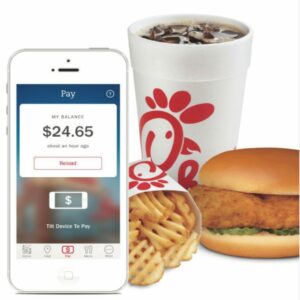 Chick-fil-A, with its newly unveiled Chick-fil-A One app, now supports location-based services, order ahead, mobile payments and a loyalty program called Treats that drove it to the top of the app store charts.
Chick-fil-A, with its newly unveiled Chick-fil-A One app, now supports location-based services, order ahead, mobile payments and a loyalty program called Treats that drove it to the top of the app store charts.
No matter the company’s industry, geography or reputation, app users are vocal about their experiences. It’s time for restaurant brands to embrace digital-first strategies that raise the bar for quality to ultimately deliver richer customer experiences that accelerate growth.
Download the PDF version of this report.
Complementary Onsite Workshops
Applause is making this report’s author available for onsite workshops that will enhance understanding of touch points across your customer journey, share insight into the best practices that industry-leading brands have embraced and determine how your company can get to market faster with a rich digital presence.
Interested? Contact bgray@applause.com.
About ARC
ARC from Applause is a research group dedicated to providing insights on the apps economy. ARC leverages data from a variety of sources, including proprietary Applause data, to provide a 360º view of app quality. ARC combines this with analysis into reports to help brands and developers understand what’s happening in the apps economy.
Learn more at http://arc.applause.com.
About Applause
Applause is a digital quality and testing company, empowering companies to deliver great digital experiences – from web to mobile to IoT to wearables and beyond. By combining in-the-wild testing services, test automation, mobile beta management and mobile sentiment analysis on which this report is based, Applause helps companies achieve the quality they need to thrive in the digital economy. Thousands of companies – including Google, Fox, Amazon, Concur and Runkeeper – rely on Applause.
Learn more at www.applause.com and follow @applause on Twitter.


















